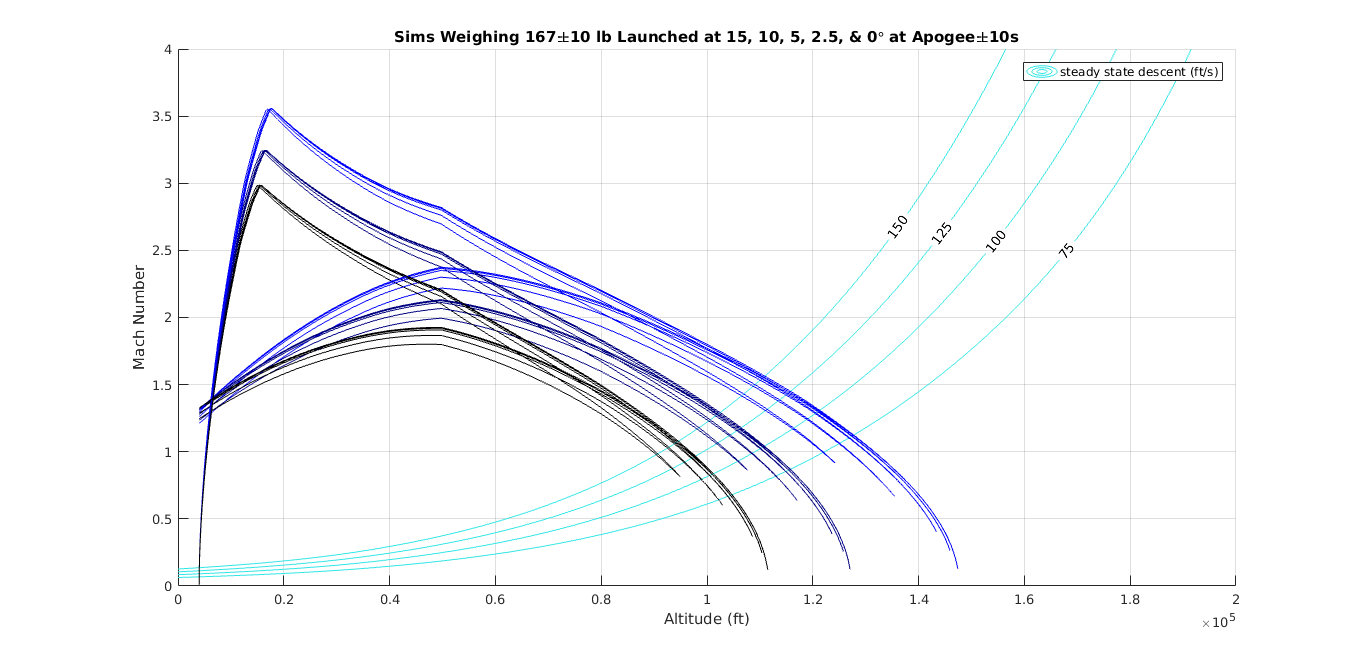Analysis
- The black, dark blue, and blue sets of lines represent the different vehicle weights (157, 167, and 177 lbs)
- The different lines within those sets represent the different launch angles
- These sets of lines follow the ascent and descent without parachute
- The light blue steady state descent lines represent descent with parachute
Design tasks
Write up analysis up until this point
See Drogue Parachute Analysis.
Recalculate forces, dynamic pressures, and descent rates for updated rocket
Opening Shock Force (Potvin, 2)
| $F=C_k(C_dS)_0\frac{1}{2}\rho v^2$ |
Stress in DGB (Clark and Tanner, 13)
| $\sigma t=\frac{F_{design}}{\pi D_{disk}}$ |
The left hand side is the stress resultant in units of force/length. It is force per width of broadcloth fabric. This analysis ignores fullness of gores compared to loading carrying members.
Ripstop Nylon MIL-C-7020 (Poynter, 70)
| Fabric, oz/yard | t, inches |
|---|---|
| 1.1 | .005 |
| 1.6 | .006 |
Find drogue Cd
Maydew gives Cd_0 = .53-.58, Dc/D0 = .73, and Dp/D0 = .65 (15).
Clark and Tanner say "It was typically assumed" that Dp/D0 = 2/3 (12). They do not give Cd anywhere, however they cite a number of papers that my give it.
Lingard has charts with Cd vs M for a number of geometric parameters (55-58). They range from .3-.6 in the subsonic range, .5-.2 in the transonic range, and .3-.5 in the supersonic range. I'm not sure what all of the geometric parameters are or what Cd is with respect to.
Ubico gives a Cd of .5 with respect to the nominal diameter of the disk. Zero porosity.
In the Lingard presentation, there is a chart, but it seems upside down. Also cites .5-.55 as a Cd range.
Cruz (Wind tunnel paper), gives Cd in terms of S0. S0 = S_disk+S_gap+S_band.
Characterize Main
Main Descent rate for FL1 was 21 ft/s. From delta altitude/delta t.
Dry weight of competition rocket: 50 lb
air density at MDRA: .00245 sg/ft^3. Based on telemetrum pressure and assuming a dry and 46F day.
Size drogue
As of December 12, the mass budget says the rocket will be about 95lb dry.
Follow Knacke 1991, chapter 7.
Pick geometric ratios
Read Clark and Tanner.
Calculate stresses and forces in components
Pick fell and hem types
See Neal & Wellings page 5.
See Poynter.
Calculate design factors
SRB drogue and main design factors (Maydew et al., 131)
Various DGB design factors (Clark and Tanner, 13)
I think Knacke has some design factor design guides
Calculate required textile strengths
Find most suitable cloths and tapes
Find suppliers and order textiles
Other tasks
Get design reviewed
Draw schematics
Determine proper assembly procedures
Review Knacke for gore fullness checks.
Enkles (in Barker with the other parachute books) has some comments.
See Poynter.
